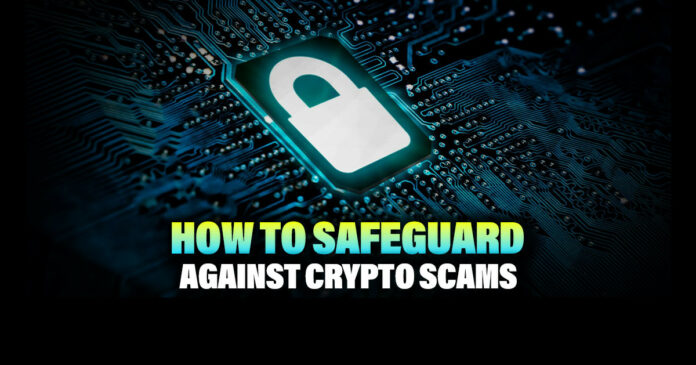
As more people make money from crypto, others are waiting to scam people off what’s in their wallets.
Let’s look at the basic rules everyone should know about wallet safety and crypto scams.
1) Seedphrase safety
When you create your wallet, you get a set of 12 or 24 words. These groups of words are what you can use to recover your crypto wallet. We recommend you write it down in your notebook. According to crypto enthusiasts, you should never give this notebook to anyone—“not even your mum.”
If your seed phrase ever gets leaked, all your funds are gone. So, write your seed phrase in a discrete notebook and keep it away from human eyes. The next step is a mistake most people make because of laziness.
Always protect your #seedphrase at all costs pic.twitter.com/RLEW0x8GvN
— GridPlus (@gridplus) February 12, 2024
2) Do not Store your Seed Phrase on your Device.
It’s easier to hack phones because we can click on links without confirming their validity. If you keep your seed phrase in the digital world, a hungry hacker can enter your device and take your hard-earned funds. So, the best step is to write it down on a notepad and keep it away from human eyes.
So many people have lost their funds through this method. Some do not even get their devices hacked, but a friend gets access to their gallery app, and boom, the funds are gone.
3) Only Connect your Wallet to verified links
Imagine a random fellow on X (Twitter) sends you a link for a job. You click on it, and before you know it, you receive notifications of successful transactions you didn’t carry out.
Always be sure to check links before clicking on them. One safety precaution is copying and pasting the link in NordVPN to check if it’s safe. Please only click on links once you confirm their safety. Here is a case:
Disclaimer: There have been many groups / persons impersonating CasperDash and performing fraud since CasperDash wallet is
Please help us to report the below “fraud” group/person. DO NOT click on any links sent by them. Verified and safe links are listed here… pic.twitter.com/U7U1a5HDWf
— Casperdash.io (@casperdash_io) July 23, 2023
4) Safeguard your Accounts with Two-factor authentication (2FA)
Use the Google Authenticator app to safeguard your account. Always use 2FA for your socials and wallets. Another use case for 2FA is to approve your wallet transactions. Before approving a transaction, you need to get a link from your Google authenticator. For this purpose, you must ensure you have a strong password on your authenticator app and that nobody has unnecessary access to your phone. Here is a case:
Be careful with phishing and other social engineering scams. Best to enable 2FA with a hardware device (Yubikey) on all crypto exchanges. https://t.co/orI7Rw3npS
— CZ BNB (@cz_binance) July 21, 2023
5) Diversify your wallet content.
Do not keep all your funds in one wallet. Diversify your fund distribution. Metamask should get a good percentage, the same as Trust Wallet and Phantom. You do not want to lose all your funds to one professional hacker.
6) Use Hardware Wallets
They are like regular hard drives. These hardware wallets hold your private keys. It’s no issue if someone can access them. They do not know your password, so they can’t make transfers. The popular hardware wallets are Ledger, Trezor, and Safepal. You can buy a hardware wallet online from websites.
Hardware wallets are safer because they are not connected online compared to your metamask and trust wallet. With hardware wallets, you must sign in using your private key whenever you transact.
Is your #Bitcoin safe from hackers & scams?
Protect your #BTC with a self-custody wallet like #KleverWallet or a hardware wallet like #KleverSafe.
With your own private keys, you’re in charge of your crypto’s security. Don’t wait until it’s too late pic.twitter.com/oyGBlLU6ej
— Klever Wallet (@klever_io) April 10, 2023
7) Mindset
Hackers are becoming more intelligent. If you are to work for/with a project, check their handles to get the appropriate links. The rule we hear every time is DYOR (Do your own research). You need to verify the information before clicking on the links.
Now, let’s look at some recent crypto scams:
Do you want free money? That’s one way scammers lure people in, especially newbies. Scammers now pose as crypto Twitter influencers and host giveaways that drain your wallet completely. The next one they do is impersonate top influencers and clone people’s accounts.
Crypto scammers are wiser now. They impersonate government officials and top asset accounts. They present themselves as the authorities to solve your problems; meanwhile, if you click the link, your funds will be gone.
Scammers cleaned out over $4 billion in crypto in 2023.
Even my brother lost 5K USDT from his wallet.
Don’t be the next victim.
Learn how to shield yourself from every type of crypto scam pic.twitter.com/uGnUiun6Jb
— Cyril – DeFi (@cyrilXBT) April 17, 2024
An Investment promising high ROI sounds exciting, but it’s a scam. You know you have to put in the work to get what you want out of any system. These scammers make enticing offers that make you forget all the crypto scam-related articles you’ve read. Always be on alert.

Disclaimer
The information discussed by Altcoin Buzz is not financial advice. This is for educational, entertainment, and informational purposes only. Any information or strategies are thoughts and opinions relevant to the accepted levels of risk tolerance of the writer/reviewers and their risk tolerance may be different than yours. We are not responsible for any losses that you may incur as a result of any investments directly or indirectly related to the information provided. Bitcoin and other cryptocurrencies are high-risk investments so please do your due diligence. Copyright Altcoin Buzz Pte Ltd.
Credit: Source link





